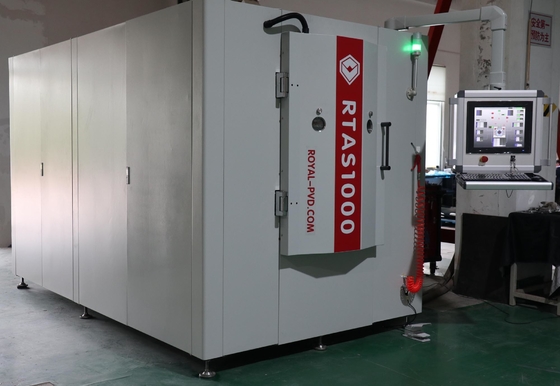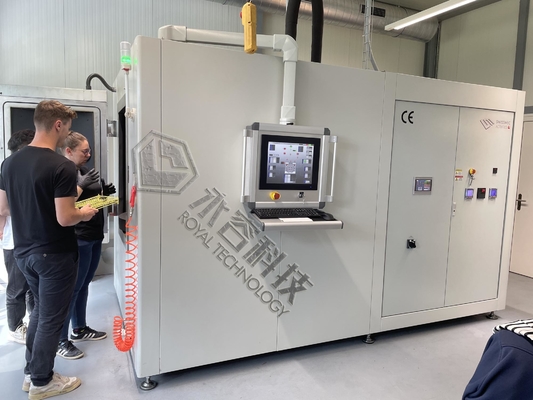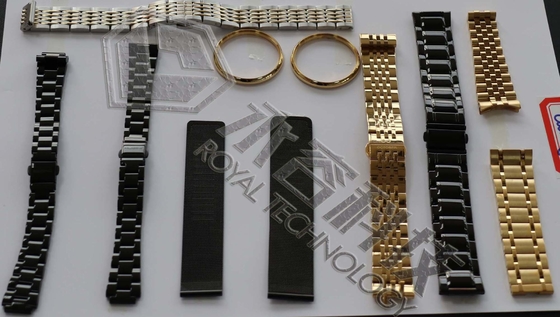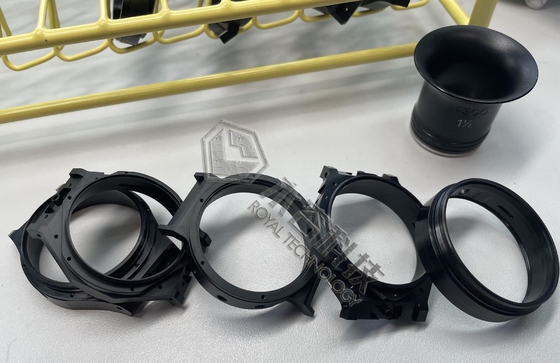
|
|






| Brand Name: | ROYAL TECHNOLOGY |
| Model Number: | RT1000-DLC |
| MOQ: | 1 |
| Price: | NEGOTIABLE |
| Payment Terms: | L/C, T/T |
| Supply Ability: | 5 sets/month |
PVD, short for Physical Vapor Deposition, is a commonly used technique for applying coatings to various surfaces, including watches.
This process offers watches enhanced durability, scratch resistance, and improved aesthetic appeal.
There are various types of PVD coatings available for watch manufacturers to use, each providing a unique finish and performance characteristics.
For example:
1. Diamond-like carbon (DLC) coating is one of the most popular PVD coatings used in watches.
This carbon-based coating is known for its high hardness, low friction, and excellent scratch resistance, enabling it to give watches a glossy black or matte finish.
2. Titanium Nitride (TiN) coating is another common coating that offers a luxurious golden color. With good scratch resistance and compatibility with metals like stainless steel, it is used in both gold-toned watches and cost-effective alternatives.
3. Titanium Carbon Nitride (TiCN) coating is a combination of titanium nitride and DLC, giving watches a dark gray or gunmetal appearance and good resistance to hardness, wear, and corrosion.
4. Titanium Aluminum Nitride (TiAlN), which fuses titanium, aluminum, and nitrogen, is also widely used in watches for its dark gray or black color, and its extra-high hardness and wear resistance. Lastly, Rose Gold PVD coatings offer watches a warm, reddish-gold color, providing an elegant and luxurious look.
The choice of PVD coating depends on the desired color, style, and performance attributes of the watch. It is important to note that while PVD coatings do provide excellent protection, they may wear off over time and with extensive use.
![]()
1. Plug-in Integrated design system for quick installation
2. Siemens PLC,CPU; with Industrial PC operation & control hardware
3. Available for remote monitoring and diagnosis.
4. Flexible, ready for upgrading
5. Multiple cathodes for fast deposition speed
![]()
PVD coatings offer several advantages compared to other types of watch coatings. Here are some key advantages of using PVD coatings:
Overall, PVD coatings offer a combination of durability, aesthetic versatility, and cost-effectiveness, making them a popular choice for watch manufacturers. They provide enhanced protection and visual appeal to timepieces, ensuring that they can withstand daily wear and maintain their appearance for an extended period.
DLC stands for Diamond-Like Carbon coating. It is a type of thin film coating that exhibits properties similar to natural diamond, such as high hardness, low friction, and chemical resistance. DLC coatings are commonly used in various industries, including automotive, aerospace, cutting tools, medical devices, and electronics.
In PVD, the DLC material is vaporized in a vacuum chamber, and the vapor then condenses onto the surface of the substrate, forming a thin film. CVD involves the reaction of a carbon-containing gas with the substrate surface to deposit the DLC coating.
The DLC coating provides several benefits depending on the application, such as improved hardness, low friction, chemical resistance, biocompatibility, and aesthetic appeal. It's worth noting that DLC coatings can vary in terms of their properties, such as hardness, adhesion, and friction coefficient, depending on the specific deposition process and parameters used.
For this reason, DLC coatings are perfect for watch components, jewelry, and other luxury metal accessories. It offers a range of advantages and finds applications in various industries where durability, low friction, and chemical resistance are desired.
![]()
Cathodic Arc Deposition:
Cathodic arc deposition involves the use of a high-voltage electric arc that is generated between a carbon-based target and the watch case surface. The target material in cathodic arc deposition is typically a carbon-based material, such as graphite or amorphous carbon. The electric arc vaporizes the carbon-based target material, creating a plasma plume consisting of highly ionized carbon species which is then directed towards the watch case and condenses onto the surface, forming the DLC coating.
Advantages of cathodic arc deposition include high ionization levels creating a dense and adherent coating, allowing for high deposition rates resulting in faster coating processes, and the ability to produce coatings with high hardness and low friction properties.
Limitations of cathodic arc deposition include limited control over the composition of the coating, challenging coating thickness uniformity to achieve, and the deposition process generating heat which may require careful temperature control.
Magnetron Sputtering:
Magnetron sputtering involves the use of low-pressure plasma and magnetic fields to generate a plasma discharge within the deposition chamber. The target material in this method is either graphite or another metal target (e.g., titanium or chromium) with a carbon-containing gas introduced into the chamber. The plasma discharge causes sputtering of metal ions from the target and accelerates them towards the watch case surface, while the carbon-containing gas dissociates into carbon ions which then bond with the metal ions on the surface, forming the back DLC coating.
The advantages of magnetron sputtering include better control over the composition of the coating, good coating thickness uniformity, and flexibility in using different target materials for improved coating properties.
Limitations of magnetron sputtering include typically slower deposition rates compared to cathodic arc deposition, careful control of gas flow and pressure needed to optimize coating quality, and coating hardness and adhesion properties which may vary depending on process parameters.
In conclusion, both cathodic arc deposition and magnetron sputtering have their advantages and limitations. The selection of the appropriate method depends on factors such as the desired coating properties, deposition rate requirements, equipment availability, and the expertise of the coating facility, and watch manufacturers should select the method that best suits their specific needs and quality standards.
The below technical parameters are only for reference, Royal Technology reserves the right for final production based on specified applications. We provide you not only the coating machine but the total coating solutions, and turnkey-project service is available.
| Model | RTAS1000 | RTAS1250 | RTAS1612 |
| Effective Chamber Size | Φ1000 x H1000mm | Φ1250 x H1250mm | Φ1600 x H1250mm |
| Deposition Sources |
Cylinder Arc (steered circular arc for option) + DC Sputtering Cathode + Linear Ion Source(for option) + MF cylinder sputtering cathodes |
||
|
Vacuum Pumping System ( Leybold Pumps + Turbo Molecular Pump)
|
SV300B *1 set (300m³/hr) | SV300B* 1 set (300m³/hr) | SV300* 2 set (300m³/hr) |
|
WAU1001-1set (1000m³/hr) |
WAU1001-1set (1000m³/hr) |
WAU2001-1set (1000m³/hr) |
|
| TRP48*1 set (48m³/hr) | TRP60*1 set (60m³/hr) | TRP90*1 set (90m³/hr) | |
|
Turbo Molecular Pumps: 1 set (3500L/S) |
Turbo Molecular Pumps: 2 sets (3500L/S) |
Turbo Molecular Pumps: 3 sets (3500L/S) |
|
| Sputtering Power Supply | 1*24KW | 1*36KW | 2*36KW |
| Arc Power Supply | 6*5KW | 7*5KW | 9*5KW |
| Bias Power Supply | 1*24KW | 1*36KW | 1*36KW |
| Planetary Rods | 6/8 | 12/16 | 20 |
| Ultimate Vacuum | 9.0*10-4Pa (empty, clean, room temperature) | 9.0*10-4Pa (empty, clean, room temperature) | 9.0*10-4Pa (empty, clean, room temperature) |
| Cycle Time (depends on pump) | 40’~50’ depends on the substrate material and coating recipes | ||
| Working Power Requirement |
3Phase 5 lines AC380V,50HZ,55KW |
3Phase 5 lines AC380V,50HZ,110KW |
3Phase 5 lines ,AC380V,50HZ,150KW |
| Cooling Water | Recycle cooling water, industrial water chiller + EDI purified water device | ||
| Processing Gas (99.99%) | 4 ways | 4 ways | 4 ways |
| Footprint (mm) | 2000*2000*2500 | 4000*4500*3200 | 5500*5000*3200 |
| Total Weight(KGS) | 4500 | 7000 | 9000 |
| Total Power Consumption(Approx.) | 50KW | 110KW | 150KW |
| Actual Power Consumption(Approx.) | 30KW | 60KW | 70KW |
The PVD Vacuum Coating Machine is carefully packaged and shipped using materials with Export standards, all components are to be packed in new cases/cartons, suitable for long-distance ocean/air and inland transportation.
![]()
![]()
![]()
2-MultiTech- DLC IPG black film coatings.pdf CLICK TO DOWNLOAD